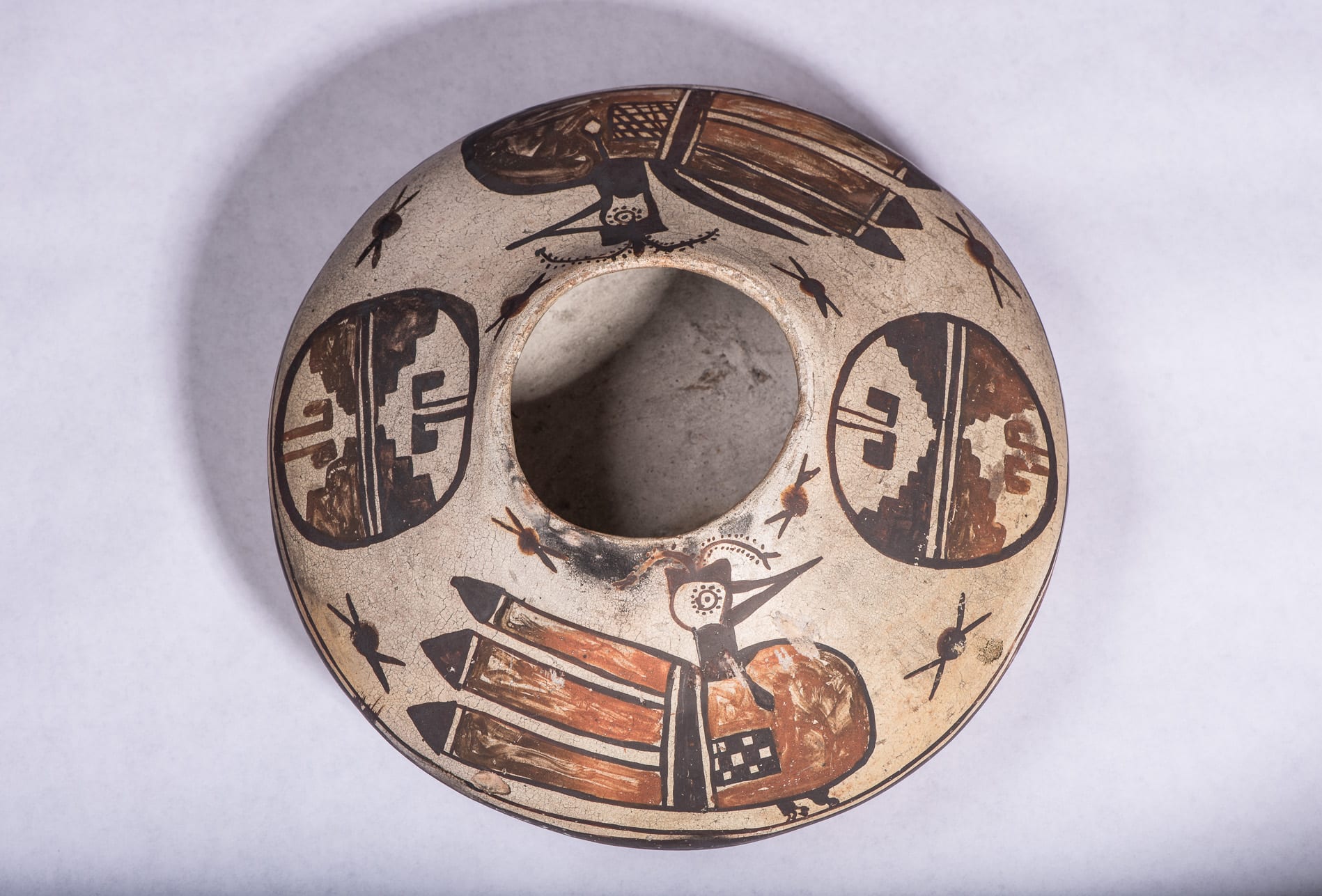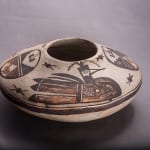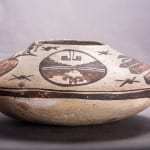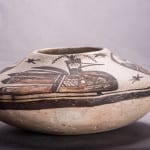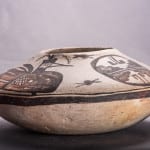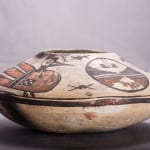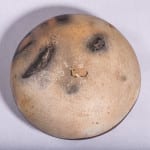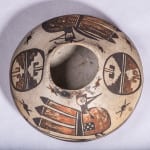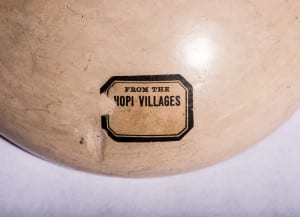- Pot 2015-05, ca late 1880’s
This is an engaging, beautiful jar.
For all its beauty, it is also a jar of contradictions;
from their interaction would come a renaissance of Hopi pottery.
Jar 2015-03 allows us a glimpse into the creative mind of the young Nampeyo.
But before I somberly explain all that, the pot needs to be celebrated because it is both beautiful and fun. Looking at it with a serious visage is impossible. The pot makes my eyes sing; folk art at its best.
The Analysis:
Form:
The lower half of jar 2015-03 is formed like a simple bowl with a slightly flattened bottom. Rising from its waist, the clay slopes sharply toward the center and forms a 3” opening. Inside, at the widest dimension of the vessel, you can see and feel where the potter used her fingers to join the upper and lower halves. This angled upper surface is the mark of a talented potter, since sharply-inclined coils of clay tend to collapse when wet. This shape was characteristic of Sikyatki type ware made 300 years before this jar. It is not a shape that was characteristic of potters of the 1880’s, when jar 2015-03 was formed.
I am not sure if the interior of the bowl is slipped or not. An exterior chip just below the tail of one of the birds reveals a light white/tan body core. The interior seems grayer and is the color of the exterior slip. This chip also reveals that the exterior slip was thickly applied. It is strikingly coarse and has the crazing that is typical of Polacca pottery of the 1880’s and 1890’s. Such scabbing of the slip is caused by a differential expansion of the core body and the slip during firing. Perhaps such crazing may not occur when the slip on the interior is protected from the direct heat of the firing. I’m just not sure. There are a couple of smudges from the firing, one above and one just below one of the birds.
Design:
This shape is perfect for decoration since the wide shoulder becomes an expansive canvass. At the pot’s widest point the artist has drawn a thick band of black. Just above it a thin line circumvents the jar. All decoration happens above these framing lines. The decoration consists of three elements: two Acoma-style birds and, equidistant between them, two roundels. Between these four designs are eight small black balls with V-shaped whiskers growing out of them. Four of these whiskered balls are placed near the mouth of the jar; below them four others are placed just above the framing lines.
Prominent are the proud Acoma birds. Referring to a jar made by Nampeyo about 35 years after jar 2015-03, Ed Wade describes them as “Acoma-influenced D-shape breasted bird(s) with dotted cartridge-like eyes, tufted head feathers, triangular slit beak, and elaborate back-thrusting tailfeathers” (Wade and Cooke, 2012:183). That’s a lot of body parts with compound adjectives, but it well describes the birds of jar 2015-03, except that here the beaks are not slit.
Notice that the two birds are slightly different. One has two small black feathers arched over her tail; the second does not. Both birds have D-shaped breasts, but they are composed of different elements. I label the bird with the two small black feathers “bird #1.” The bird without these black feathers is “bird #2,”
Bird #1: The breast of bird #1 is filled in roughly with blotchy brownish/black paint. While roughly
D-shaped, the lower boundary is flat and is parallel to the thin framing line. Hanging by a black thread from the bird’s neck is an unpainted diamond-shaped pendant. Behind this pendant toward the midsection of bird #1 is a black box. It seems like a diagonal was drawn from the upper left corner of the box to the lower right corner. Three parallel lines were drawn above and parallel to this diagonal, four similar lines below. Four lines parallel with the bottom of the box were then drawn across the first pattern, resulting in about 28 cells inside the box. The painting seems sloppy.
Rising from the rear of the bird’s breast is a short black neck topped by an eye composed of a circle with a dot in the middle, orbited by 9 additional dots. The eye is then topped by a roughly square-shaped black crest connected to the black area below by a thin rectangular black area behind the eye. Topping the crest is a short black stalk that sprouts forward and rear-facing antenna. To form the a antenna, the potter has drawn two shoots at a sharp upward angle until she reached the rim of the jar, and then lifted her brush to continue the antenna in a downward direction. Each antenna is surrounded by a swarm of 20 to 25 black dots. The beak is an undifferentiated triangle painted in front of the eye.
There is a thick black belt around the midsection of bird #1, flanked by two thin unpainted stripes.
From the top of this linear pattern and behind her neck sprout two pointed solid black feathers, the thicker above the thinner.
Three back-thrusting tail feathers are of a simple design: each a blotchy red rectangle, followed by a thin unpainted stripe that reflects the midsection stripes, followed by rectangular black tips. The top feather is somewhat narrower than the bottom two.
Underneath bird #1, squeezed between the breast and the thin framing line like an afterthought, is a small black ball intended to represent feet.
Bird #2: This bird is similar to bird #1, but significantly simpler. The breast of bird #2 is the expected D-shape but the boundary remains curved from the neck to the underbelly. It is painted with a fairly uniform blotchy red paint. Hanging by a black thread from the bird’s neck is a solid black diamond-shaped pendant. Below this pendant toward the rear of the breast is a black box. Inside is a checkerboard pattern of 6 relatively large white squares that seem to have been drawn front to back against a black background. The final two small white rectangles on the left edge inside the box appear to have been added as an afterthought. All of these details are different than bird #1.
Rising from the rear of her breast is a neck and head that are very similar to that on bird #1.
Only the construction of the antenna is slightly different. On bird #2 the antenna form smoother arcs since they do not touch the lip. In contrast to the first bird, each antenna on bird #2 end with a Y-shaped branch. About 20 to 25 dots surround these antennae, though the rear-facing antenna is somewhat obscured by a firing smudge.
Both birds have very similar midsection belts, though the belt on bird #2 is wider and its sides not as parallel as that on the first bird. The three back thrusting tail feathers on bird #2 have the same construction and proportions as those on bird #1.
Underneath bird #2 between the breast and the thin framing line are two stubby legs with talons.
Although crudely-drawn, they offer far more detail than the simple black ball under bird #1.
In short, the two bird motifs are substantially similar but have significant differences. So numerous are these differences that I wonder if they might be intentional. Perhaps the painter was trying to depict male and female images of the same species of bird. One hundred and thirty years after the pot was created, this is mere speculation.
In contrast to the birds, the two circular motifs on the jar are composed of the same elements of design, but here too we find difference. I will call the circular image in front of bird #1 “roundel #1” and the other “roundel #2.”
Roundel #1: The circle that frames roundel #1 is crudely drawn. The boundary line varies from thin (at the 2 to 3 o’clock position) to thick (from 4 to 8 o’clock). At about 11 o’clock it is at its thickest and slightly pointed on the outer edge. Inside, the elements of the motif are carefully drawn.
Two crooks hang from the 12 o’clock position and extend about 25% of the way across the design. The crooks are turned so that their handles are open to the left and right. A slight unpainted area separates the two crooks. A similar pair reaches up into the design from the 6 o’clock position. The handles on the upper pair are quite similar and quite thick. The handles on the lower pair are more delicately drawn, though it seems that the painter ran out of room on the bottom right and the handle of this crook was completely filled in.
Running from 9 to 3 o’clock are three black lines forming a two-lane highway. Above and below this linear element are four stepped cloud images with their base against the outer circle. In pairs these form bisected stepped pyramids with 3 to 5 squared steps on each side.
The lower half of roundel #1 is painted with a muddy rust red paint seen earlier on the breast of bird #1. The top is painted with a darker muddy brown paint, though variations in paint thickness make it difficult to judge color consistently. The color contrast is most clear between the pairs of crooks.
Roundel #2: The pairs of crooks in this roundel seem quite similar except that the stems of the crooks in the top pair are thinner than the bottom pair. The half pyramids above the centerline are similarly and carefully drawn, with one having six steps and one seven. In contrast the half pyramids below the centerline are much less-carefully drawn. The left half pyramid has four or five squared steps, a flake in the paint makes the number unclear. The reduced number of steps makes this image chunkier that those we see in the top half of this roundel.. The right lower half pyramid may have been the last drawn since it seems jammed into the space and its shape is distorted. Its slope is much steeper and its steps less prominent than any other similar element on jar 2015-03. The images in the lower half of roundel #2 are clearly painted with red paint, the top drawn with black paint.
As noted below in an email from Ed Wade, these two circular motifs are seen as shields in kiva murals and variations of the design are found on prehistoric Hopi black and white pottery. It is always dangerous for a Pahana to speculate on the meaning of old designs, but following Patterson (1994:141,152), the meaning of the shields seems interpretable. The stepped images are rain clouds, the crooks the resulting sprouts of growing plants (corn?). Collectively the shields are a prayer for an abundant life.
Whiskered balls: The eight whiskered balls are the only remaining design element on jar 2015-03.
It seems that the balls are a bit more complex than first glance would suggest. Black paint was used to draw a small central ball with a pair of v-shaped whiskers extending from each side. Red paint was then used to draw a larger ball around the black core. The muddy nature of the paint continues to make distinguishing color difficult, but this pattern of paint is clear enough on most of the eight whiskered elements, that I am fairly certain of the pattern. I know that the Hopi associate different colors with different directions, but I have no idea if the colors in this element had any meaning to its maker. Walter Jesse Fewkes interprets these balled images on jar 2015-03 as “pahos,” prayer feathers that carry hopes for rain (1919:241 and plate 78; also 1973:139 and plate 78). About 25 years after jar 2015-03 was made, Nampeyo used a half moon with whiskers as a central element on one of her bowls in this collection (2014-20).
Lack of wear: Jar-2015-03 is in pristine condition without wear. This is also true of nearly all the pots in the Keam Collection of Polacca ware in the Peabody Museum of Harvard University and indicates that the jar was made for commercial purpose and not for home use (Wade & McChesney, 1981: 143; Wade and Cooke, 2012: 124). Reinforcing this conclusion is the fragmentary black-bordered sticker on the bottom of jar 2015-03 of which only the letters “Hop” can be read. The sticker is identical to those found on a few other pots in this collection (cf 2013-17) which read in full “From the Hopi Villages.” This label indicates that jar 2015-03 was sold by the Fred Harvey Company, perhaps at Hopi House at the Grand Canyon or one of their hotels along a railroad line. The Harvey Company did not use these labels until 1905. I believe jar 2015-03 was made about 1893 and initially traded to Thomas Keam. “Throughout the 1880’s (Keam) was stockpiling both antiquities and modern Hopi arts and crafts for sale to tourists and museum collectors (Wade and Cooke, 2012:124).” Where pot 2015-03 spent the years between 1893 and 1905 remains a mystery.
Who made jar 2015-03: Nampeyo?
Based on an analysis of pottery made by Nampeyo during her Sikyatki Revival period, I have found six defining characteristics of Nampeyo’s mature painting style (Appendix B). Although this schema is based on her work decades after jar 2015-03 was made, their application to her early work has been fruitful (see the entry for 2012-02). Thus I repeat that analysis here. When we apply these criteria to jar 2015-03 we gain new insights into the development of Nampeyo’s creative mind. The six strategies are:
- A tension between linear and curvilinear elements often represented as a contrast between heavy and delicate elements.
On her later work Nampeyo generally combined linear and curvilinear elements into the same motif (cf bowl 1993-04 and jar 2005-16). No such clear pattern is seen on jar 2015-03, yet the tails of the birds are dramatically linear while the D-shaped breasts and shields are curvilinear. The eight balls with whiskers incorporate both elements. The effect is not the same as on later pots, and thus the design on 2015-03 seems to be smoothly sailing around the jar and is largely without tension. Visual interest is stirred by mixing linear and curvilinear elements. Perhaps Nampeyo was playing with shapes and forms here and would later build on this experience in her more mature years. - A deliberate asymmetry of design.
At first look the design on jar 2015-03 looks symmetrical. Two birds sit in opposite quadrants of the jar, as do the two shields. Those whiskered balls are placed evenly around the jar. All seems orderly. Yet asymmetry exists, most obviously the inclusion of a pair of small black wings on bird #1 and their omission from bird #2. The designs internal to the breasts of each bird are also different. The ends of the bird antennae are different. The other motifs on the jar seem to reflect each other more closely. It’s not clear if the asymmetry is intentional or not. - The use of color to integrate design elements.
The muddy nature of the paint makes direct comparison of color a matter of degree, but each bird contains major areas of red and this links the two images across the jar. Red paint is clearly used to draw the lower half of shield #2, this is probably also true of shield #1, though the varying thickness and muddiness of the paint make this less clear. Moreover the whiskered balls also incorporate red. If shield # 1 is seen as using red paint, then every element of the design incorporates red, thus integrating the design. - The use of empty (negative) space to frame the painted image.
The use of negative space to frame designs is not a characteristic of Polacca D ware, yet here the painter has left substantial unpainted areas on the upper surface of the jar. Each element of design on jar 2015-03 seems to float in its own space. - The use of a thick above a thin framing line on the interior rim of her bowls.
Nampeyo’s canteens are painted as if they are her bowls made convex, so that the order of the framing lines is reversed (cf 1999-03, 2010-11 or 2012-13). The same thin above thick framing line pattern is seen here. This use of thick above thin framing lines is not found on Polacca ware. - Confident, bold, and impulsive painting.
While this is the most intangible of Nampeyo’s six design strategies, it is what is generally recognized first, like picking the familiar face of a friend out of a crowd. Here much of the painting lacks such confident strokes. There are impulsive elements, like the two small white rectangles in the square on the breast of bird #2, but the parallel element on the breast of bird #1 is more of a mess than “impulsive,” as is the lower left red stepped cloud element on shield #2. “Confident” is not a descriptor that comes to mind when reviewing the painting on jar 2015-03.
These 6 design strategies represent a sort of “ideal type” of the pottery that Nampeyo produced from about 1905 to about 1920, what I call her mature Sikyatki Revival style. I find it a useful tool when trying to decide if a pot from this era is by Nampeyo. But what does it mean when a jar like 2015-03 produced 20 years earlier does not fully meet its standards?
One has to change the definition of what one is looking for in order for strategy #1 (linear v curvilinear) to apply to jar 2015-03. Strategy #2 (asymmetry) is also found, but not as part of an integrated overall design, which is more characteristic of Nampeyo’s later work. The next three design strategies (the use of color to integrate the design, negative space to frame design elements, and thick/thin framing lines) do seem fully present on jar 2015-03. Finally, compared to her work 20 years later, the painting is not confident.
The cover of American Indian Art Magazine for the Autumn of 2013 shows a large olla belonging to National Museum of Natural History, Smithsonian Institution and collected by Jesse Fewkes in 1895. On the neck of the jar are seen two sets of 4 and 5 linear red feathers with black triangular caps that are identical in form to those forming the Acoma bird tails on jar 2015-03. The red paint on the jar in this collection is muddier and less-carefully applied than on the Smithsonian jar, a consequence of its firing. In an accompanying article David Schramm links the design elements on the Smithsonian jar to known examples of Nampeyo’s work and concludes that the jar is by Nampeyo, ca “the late 1880’s or the early 1900’s (2013:81).”
Based on this accumulated evidence, I believe that Nampeyo form and decorated jar 2015-03.
I think jar 2015-03 is particularly important because it offers insights into the creative mind of a master potter learning her trade, emphasis on “learning.” Nampeyo is in process here and the deviations from the norms of the six-point typology highlight the path of her future. This jar gives us insight about where she was in her creative youth.
To illustrate this point, compare jar 2015-03 to the other “folky” Nampeyo pot in the collection, bowl 2012-21 made about 25 years after the Acoma-style bird jar analyzed here.. Bowl 2012-21 seems like folk art because of the exuberant flock of 5 hummingbirds careening around its interior. While the folk art sensibility of the two pots seems similar, I think they represent Nampeyo at very different points in her aesthetic ability.
The interior design of the hummingbird bowl seems playful, but this bowl has an external glyph that is the most aesthetically sophisticated in the collection. The contrast in styles between the interior and exterior designs on the hummingbird bowl suggests that the interior of this bowl is an intentionally playful design by the mature Nampeyo after she had achieved extraordinary mastery of design technique. In contrast the much older Acoma style jar 2015-03 represents the best work of a young Nampeyo still trying to master the art of design.
Ed Wade has pointed out that “The ‘Nampeyo’ proudly displayed in many collections is an act of wishful thinking, one sustained by the dearth of solid scholarship (Wade and Cooke, 2012:126,” and of course I am subject to such self-deception. I may be trying too hard to prove that jar 2015-03 is indeed a Nampeyo.
But I think not, and here’s why.
The crackled slip on jar 2015-03 is characteristic of Polacca ware, yet:
- Polacca ware often used two thin framing lines, but not the thick/thin framing lines used here. That tradition reflects the Sikyatki style 300 or more years before jar 2015-03 was made.
- Similarly, the women who produced Polacca ware filled the design area and did not leave negative space around design elements, as seen here. Again, such use of negative space is a Sikyatki tradition (Wade and McChesney, 1981:143).
- The broad-shouldered saucer shape of jar 2015-03 is not a Polacca shape, but (once again) is is inspired by Sikyatki ware.
- The D-breasted bird design has no precedence in Polacca ware but is directly borrowed from Acoma Pueblo 200 miles southeast of the Hopi mesas.
These four points are direct evidence that we are dealing with a potter looking outside of Polacca ware ceramic traditions to express her aesthetic vision. Jar 2015-03 is Polacca polychrome because of its crackled slip, but its shape and design are innovations. In the 1880’s this pattern of innovation points to only one potter: Nampeyo.
So how does jar 2015-03 fit into Nampeyo’s evolving style?
Wade defines five approaches that are characteristic of Nampeyo’s evolving style. Pots in this collection represent four of these approaches and I have noted their catalog numbers below (Wade and Cooke, 2012:128-133):
- Polacca-Zuni 1880-1900 (no pots in this collection).
- Prehistoric Revival 1880-1910 (2009-08 and 2012-02)
- Sikyatki Revival 1890-1930 (1993-04, 2005-16 and many more)
- Pan-Puebloan 1880-1920’s (2015-03)*
- Curvilinear Abstraction 1900-1930 (2006-11, 2015-04)
Jar 2015-03 was probably made after Nampeyo’s “Polacca-Zuni” period and is an example of her Pan-Puebloan period, here borrowing the bird design from Acoma:
“Following Nampeyo’s Polacca-Zuni period in the 1880’s, things become a bit more complicated as she simultaneously embraced Prehistoric-Revival, Pan-Puebloan, and even the earliest Sikyatki Revival conventions. These were applied to what technically would be classified Polacca Polychrome, although at times she also invented new…slips (Wade and Cooke, 2012:130).
One pot in this collection particularly exemplifies the possibility of mix stylistic approaches, pot 2017-04, “Tray with Polacca-style Polik’Mana interior and Sikyatki Revival exterior.”
Wade notes that Nampeyo’s use of these 5 styles is not linear:
“…over the course of her long career (Nampeyo) frequently revisited a favored shape or design….as evidenced by the Acoma-Zia influenced bird which appeared on her Polacca jars during the 1880’s (Wade and Cooke, 2012:128.)”
Nampeyo scholar Vincent Drucker drew my attention to a documented Nampeyo jar that was photographed in 1893 as part of the Smithsonian Museum’s effort to develop an accurate diorama for the 1893 World’s Fair in Chicago:

James Mooney photo ca 1893. Smithsonian Institution Anthropological Archives #09644200.
Here is the quintessential Hopi domestic scene: a mother (with straight hair) grinding corn that is being used by her unmarried daughter (with hair whorls) to make piki bread, a basic Hopi food. The Nampeyo jar to the right of the women is being used as a prop.
The jar is now in a private collection:

c 1892. D:13 inches; H: 7 7/8 inches
Note that the central motif is contained under a squared-off “rainbow” element that is characteristic of Acoma pottery design. For our purposes this pot is evidence that by 1892 Nampeyo was looking at Acoma pots for inspiration when making pots at Hopi.
Jar 2015-03 in this collection is another example of Nampeyo’s interest in Acoma design early in her career. It’s hard to tell from a photograph, but the painting on the jar incorporating the Acoma rainbow element seems somewhat better-painted than jar 2015-03, perhaps making the jar in this collection a bit earlier.
Hopi pottery lovers at the “fanatic” stage of collection are a small and motivated bunch. We share images of our pottery, trade information about potters and comment on museum exhibitions, but we are also rivals as we bid against each other at auction. Humor helps maintain our friendships, as can be seen in the email comment, below.
The auction house that sold jar 2015-03 listed it as “A Southwest Pottery Acoma Bowl” based on the style of the birds. When I emailed Ed Wade after the auction about the pot, he replied:
“A great pot indeed since I was the underbidder on it. You do know that it is a Nampeyo? This Acoma bird form appeared on a number of her 1900 – 1910 jars such as the one at the Spencer Museum in Kansas. Yours however is a Polacca Polychrome and the earliest example of this figurative bird that I know of c. 1890. You’re totally correct that the label was applied later and the jar was likely in the possession of Thomas Keam. The circular forms can be viewed as shields in Kiva murals but also were common to ancestral Hopi Black on white traditions. A truly wonderful piece and it was almost mine. Ed.”
Ed Wade published four photographs of the Spencer Museum pot in his 2022 book The Call of Beauty, page 88-89. The central designs on the Spencer Museum jar are four Acoma bird framed by a two-color rainbow element. This pot has both similarities and differences with jar 2005-03 and both patterns are telling. Both jars depict birds having similarly constructed heads and antenna, D-shaped breasts showing square inserts and red linear tails with black tips and incidentally-drawn feet. There are important differences in slip and painting however. It’s difficult to tell from photographs, but the slip on my jar 2015-03 seems coarser and more crazed than the Spencer jar. [Ed remarks on the “fineness of the slip” on the museum jar (2022:88).] The complexity of the design is much greater on the Spencer jar than my jar and the drawing on the museum jar is more exact and done with a lighter hand. The similarities between the jars support the feeling that Nampeyo made both pots. The differences between the jars suggest (as Ed Wade wrote) that my jar was made earlier than the Spencer jar when the prevailing slip used at Hopi was coarser and when Nampeyo was still developing her design and painting skills.
The museum dates their jar as 1890 while Wade suggests it was made about 1895-1900 because of the fineness of the slip.
I have located five other Nampeyo pots that incorporate the “Acoma-influenced D-shape breasted bird with dotted cartridge-like eyes, tufted head feathers, triangular slit beak, and elaborate back-thrusting tailfeathers” design (Wade, 2012:183). From oldest to youngest:
- During her Indian Market sale in August of 2014, Marti Streuver offered a broad-shouldered jar by Nampeyo dated ca. 1900 with about the diameter of 2015-03. Judging from a small color photograph, this jar seems carefully rag-wiped with white Kaolin slip, as on bowl 2012-02 in this collection. This slip does not appear scabbed in the Polacca manner, as on jar 2015-03. The bird is contained within a red and black arc, which also enclosed a split cloud and a branch of berries on which the bird is feeding. Like the Tulane bowl discussed next, the head of the bird on the Streuver jar is formed from a half star and has branched antennae. While certainly folk art, the bird on the Streuver jar pot is more-carefully composed and painted than on jar 2015-03. On the Streuver pot the three tail feathers are more equal in size and the red paint is strikingly less-muddy and evenly applied than on the jar 2015-03. Nevertheless, a) the broad-shouldered form of the Streuver pot, b) the double branching of the bird’s antennae and c) the use of simple circular elements to fill in between the birds suggest that the Streuver pot and jar 2015-03 are sisters who emerged from the same mother with my jar somewhat older.
- The Blairs (1999: color figure 2.31G) reproduce a photograph of a Nampeyo bowl collected by George Pepper ca 1901-1903 and now in the collection of The Middle American Research Institute of Tulane University in New Orleans. The Tulane bowl seems unslipped or is slipped with the same warm orange slip that is characteristic of Sikyatki Revival ware. The design on the Tulane bowl omits the arc but incorporates versions of the berries and split cloud, elements seen on the Streuver bowl but not jar 2015-03. Like jar 2015-03 and the Streuver jar, this rendition has branched antennae. The bird on the Tulane bowl has legs and feet, an element missing from the design on the four other jars discussed . As with the Streuver jar, the painting on this bowl is more carefully drawn and the colors cleaner than on jar 2015-03.
- Steve Elmore reprints (2015:185) the photograph of a tall ca. 1910 Sikyatki Revival jar by Nampeyo in the Peabody Museum of Harvard. On the shoulder of the jar Nampeyo has painted an Acoma-like bird. The single-direction antenna and round head are characteristic of later renditions of this image by Nampeyo, but contrast to the jar in my collection. The image contains a split-cloud element seen on earlier pots of this design, but missing from jar 2015-03 . Again, the painting is strikingly more precise than on 2015-03.
- The Cooke Collection contains a large, elaborately decorated Nampeyo jar that incorporates a version of her Acoma bird (Wade and Cooke, 2012:180-183). The design is more crowded than on the pots already discussed, an unusual layout for Nampeyo. This version is different than those already discussed since it omits antennae and has four tail feathers rather than the customary three. The design elements that compose the body of the bird form a more complex pattern than on earlier versions; the painting precise. Still, after reviewing the earlier examples of this design, the familiar hand of Nampeyo is clear.
- A Hopi jar of similar shape and design to 2015-03 is in the collection of The Museum of the Red River, Isabel, OK, catalog #99.18.73. They date it as ca 1880. I have only one photograph of the Red River pot and it shows a D-breasted bird with substantially more elaborate tail feathers than seen on 2015-03 in this collection. The Red river pot also shows star-shaped “shields” as a second design element, though it lacks the whiskered balls on 2015-03. It is cataloged as made by an “unknown” potter (Photograph on file.)
Nampeyo evolved the Acoma-style motif over the approximately 35 years represented by jar 2015-03 and the pots reviewed here. Nevertheless, there are strong similarities between the pot in this collection and later versions:
- All have birds with prominent D-shaped breasts.
- All have the dotted cartridge-like eyes.
- All have triangular beaks; on all but the jar in this collection the beak has a slit.
- Four of the five have 3 simple linear back-thrusting tail feathers, the exception being the most recent jar.
- Three have an unpainted diamond design on the breast of at least one bird; the Cooke jar shows an unpainted triangle, the Elmore jar has no such design.
- The three oldest pots, including the one in this collection, have double-branched antennae.
In short,
- based on an analysis of jar 2015-03’s form, slip and design,
- based on a comparison of the design on jar 2015-03 and the six design strategies I expect to find on Nampeyo’s later work, and
- based on a comparison of jar 2015-03 with six other Nampeyo jars using the Acoma bird design,
I am confident that jar 2015-03 is a very early example of Nampeyo ‘s work. While genius is constant, the technical skill and vision of an artist may evolve, as is seen here.
How jar 2015-03 fits into this collection.
There are now 66 pots in this collection that seem to have been either a) formed or b) formed and painted by Nampeyo. (See the Artist List and Appendix D.) Of these, 6 were probably made in the 19th century, including jar 2015-03.
Ordered by my best guess as to their age, these oldest Nampeyo pots are:
- 2015-03: Seedjar with Acoma-style birds (late 1880’s or 1990)
- 2009-17: A mixing or piki bowl with Polik’Mana design (c 1890)
- 2009-08: Small dish with footprint image (c 1890)
- 2014-10: Tile with Polik’Mana image (c 1897-1900)
- 2012-02: Black-on-cream bowl with flared lip and Kayenta design (c 1895-1901)
- 1993-04: Bowl with “bird hanging from skyband” design (c 1895-1910)
Jar 2015-03 is the oldest Nampeyo pot in the collection.
It is also the Nampeyo pot with the least confident painting technique.
It extends this collection back to a time when we can experience genius finding her ability.

